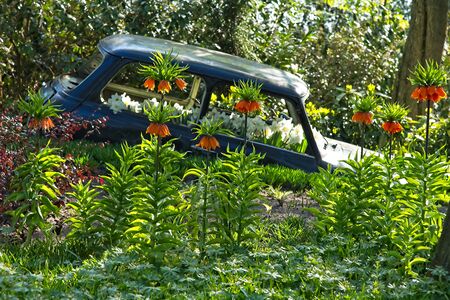1. Understanding Invasive Garden Insects
Have you ever spotted a strange bug munching on your tomatoes or roses, and wondered where it came from? Chances are, you’ve met an invasive garden insect. But what exactly does “invasive” mean when we’re talking about bugs in American gardens?
What Makes an Insect Invasive?
An invasive insect isn’t just any unwelcome critter. These are species that aren’t native to the United States but have found their way here—often hitching rides with imported plants, wood, soil, or even travelers’ luggage. Once they arrive, invasive insects can spread rapidly because they usually don’t have natural predators in their new environment. This lets them multiply fast and outcompete local bugs.
Why Are Invasive Insects a Problem?
When invasive insects set up shop in your garden, they can cause a lot of trouble:
- Crop Damage: They feed on vegetables, fruits, and flowers, sometimes destroying entire crops.
- Native Species at Risk: They compete with or prey on native insects and animals.
- Disease Spread: Some invasives carry plant diseases that threaten both home gardens and farms.
- Pesticide Use: Managing invasives often means more chemicals, which isn’t great for the environment.
How Do Invasive Insects Reach American Gardens?
You might be surprised by how these tiny invaders travel across continents! Here are some common ways they get into our backyards:
| Pathway | Description | Example |
|---|---|---|
| Imported Plants & Soil | Eggs or larvae hide in nursery plants or potting soil shipped from overseas. | Japanese beetle grubs in sod rolls |
| Packing Materials | Bugs ride along in wooden crates or pallets used for shipping goods. | Emerald ash borer in wooden packing |
| Luggage & Vehicles | Insects stow away in suitcases or cars traveling between countries. | Brown marmorated stink bug in luggage |
| Wind & Weather Events | Storms can carry flying insects over borders naturally. | Moths blown northward during hurricanes |
The first step to protecting your garden is knowing what to look for and understanding how these pests make their way to your backyard. In the next section, well start exploring some of the most notorious invaders and how to spot them!
2. Common Culprits: Identifying Invaders in Your Garden
Invasive insects can sneak into our backyards and cause real headaches for home gardeners. Recognizing these unwelcome guests early is the first step to keeping your garden healthy. Here’s a friendly guide to some of the most common invasive garden insects found across the U.S., how to spot them, and how to tell them apart from similar-looking native bugs.
Top Invasive Insects Found in American Gardens
| Insect Name | Photo | Key Features | Lookalike Native Species | How to Tell Them Apart |
|---|---|---|---|---|
| Japanese Beetle (Popillia japonica) |
 |
Shiny metallic green body, copper-brown wings, white tufts along sides | Green June Beetle (Cotinis nitida) |
Larger size, matte green with no copper wings or side tufts |
| Emerald Ash Borer (Agrilus planipennis) |
 |
Slim, bright metallic green beetle, about ½ inch long | Six-Spotted Tiger Beetle (Cicindela sexguttata) |
Tiger beetles are rounder, faster-moving, often with white spots |
| Brown Marmorated Stink Bug (Halyomorpha halys) |
 |
Mottled brown shield shape, white bands on antennae and legs | Native Green Stink Bug (Chinavia hilaris) |
Native stink bugs are usually solid green with no banded antennae |
| Lily Leaf Beetle (Lilioceris lilii) |
 |
Bright red body, black legs and antennae, feeds on lilies and fritillaries | Cardinal Beetle (Pyrochroa spp.) |
Lily leaf beetles are smaller and exclusively attack lilies; cardinal beetles are broader and don’t target garden lilies |
| Spotted Lanternfly (Lycorma delicatula) |
 |
Gray wings with black spots, red hind wings, hops rather than flies far | Mourning Cloak Butterfly Caterpillar (Nymphalis antiopa) |
Caterpillars are worm-like; adult lanternflies look more like moths with spots and hop when disturbed |
Why Identification Matters
Many invasive insects look a lot like local species that actually help our gardens. Misidentifying them can lead to harming pollinators or other beneficial bugs. When you spot an unfamiliar insect, compare it carefully to the details above or snap a photo for your local extension office or Master Gardener group.
Tips for Spotting Invaders Early
- Check plants regularly—especially new growth and undersides of leaves.
- Look for signs like holes in leaves, sticky residue (honeydew), or odd webbing.
- If you’re unsure about an insect’s identity, take a clear photo and ask for help online or at a local gardening center.
- Keep track of what you find! A simple garden notebook helps spot patterns over time.
Your Eyes Are Your Best Tool!
The sooner you spot invasive insects in your garden, the easier it is to manage them. Stay curious and observant—the health of your backyard ecosystem depends on it!

3. Spotting the Signs: Insect Damage and Evidence
If you want to keep your garden healthy and thriving, catching invasive insects early is key. These little invaders often leave behind clues long before you spot them crawling around. Learning to recognize the signs of insect activity can save you time, money, and a lot of heartache. Here are some practical tips for spotting early signs of trouble in your garden.
Common Signs of Invasive Insect Activity
Invasive insects don’t always make themselves obvious, but they do leave damage in their wake. Some of the most common indicators include:
- Chewed or ragged leaves – Jagged edges or holes in leaves can signal beetles, caterpillars, or weevils.
- Yellowing or wilting plants – Sap-sucking insects like aphids or whiteflies weaken plants from the inside out.
- Sticky residue (honeydew) – If you notice a shiny, sticky coating on leaves or under plants, sap-feeders may be present.
- Sawdust-like deposits – Fine powder at the base of stems or trees may mean borers are tunneling inside.
- Odd bumps or galls – Swellings on stems or leaves can be caused by feeding or egg-laying insects.
- Webbing or silk threads – Many moth larvae and spider mites spin webs as they feed and move around.
- Tiny black specks (frass) – Caterpillar droppings collect on leaves and soil below infested plants.
Quick Reference Table: Signs and Suspected Invaders
| Sign in Garden | Possible Insect Culprit | Where to Look |
|---|---|---|
| Holes in Leaves | Caterpillars, Japanese Beetles | Tops and undersides of leaves |
| Sticky Residue (Honeydew) | Aphids, Whiteflies, Scale Insects | Leaf surfaces, nearby soil |
| Sawdust-Like Debris | Borers (Emerald Ash Borer, Asian Longhorned Beetle) | Bases of trunks/stems, bark crevices |
| Bumpy Galls on Leaves/Stems | Psyllids, Gall Wasps | Lumps on stems or leaf veins |
| Fine Webbing | Spider Mites, Webworms | Corners of leaves, branch tips |
| Tiny Black Droppings (Frass) | Caterpillars, Leaf Beetles | On lower leaves, soil beneath plants |
| Yellowing/Wilting Plants | Aphids, Root Weevils, Whiteflies | Whole plant; check roots and leaf undersides too |
Tips for Catching Problems Early
- Inspect regularly: Walk through your garden at least once a week with a keen eye. Flip over leaves, look closely at stems and check near the soil line.
- Tune into changes: Get to know what “normal” looks like for your plants so odd colors, spots, or textures stand out quickly.
- Use a magnifying glass: Tiny eggs or bugs often hide out of sight. A small hand lens can reveal what’s going on up close.
- Look for patterns: If one type of plant is struggling while others are fine, focus your search there first—some invaders have favorites!
- Keep records: Jot down unusual findings in a garden notebook. This helps track recurring problems and spot trends over time.
- Tidy up debris: Fallen leaves and dead stems can hide pests or their eggs—clean regularly to cut down on hiding places.
Your Local Extension Can Help!
If you’re ever unsure about what’s causing damage in your garden, don’t hesitate to reach out to your local Cooperative Extension office. They offer expert advice tailored to your region and can help you identify unknown bugs or symptoms. Early action makes all the difference when dealing with invasive insects!
4. Management Strategies That Work
When you spot invasive insects in your garden, acting quickly and wisely can make all the difference. Here are some practical, eco-friendly methods to keep your family garden healthy—without harming pollinators or pets.
Organic Methods for Family Gardens
Going organic is not only better for the environment but also safer for kids and pets who love to explore outdoors. Here are some tried-and-true options:
| Method | How It Works | Best For |
|---|---|---|
| Hand-picking | Simply remove visible bugs and egg masses by hand or with a small brush. | Larger pests like Japanese beetles or spotted lanternfly nymphs. |
| Neem Oil Spray | A natural oil that disrupts insect life cycles; spray directly on affected plants. | Aphids, whiteflies, mealybugs. |
| Diatomaceous Earth | Sprinkle around plants; it damages insect exoskeletons but is safe for humans and pets. | Crawling insects such as ants and earwigs. |
| Beneficial Insects | Release ladybugs or lacewings to prey on harmful invaders naturally. | Aphids, mites, soft-bodied pests. |
| Soap Sprays | Mild dish soap mixed with water suffocates soft-bodied insects. | Aphids, spider mites, whiteflies. |
Physical Barriers and Traps
Sometimes the simplest solutions work best. Physical barriers can keep invaders out without any sprays at all:
- Row Covers: Lightweight fabric keeps flying insects from reaching your veggies—just remember to remove them during flowering for pollination!
- Sticky Traps: Bright yellow or blue cards coated with sticky material attract and trap flying insects like whiteflies or thrips.
- Copper Tape: Placing copper tape around raised beds deters slugs and snails naturally.
Safe Chemical Options (When You Really Need Them)
If organic methods aren’t cutting it, there are some low-impact chemical choices that can be used carefully in family gardens:
- Insecticidal Soaps: These target only soft-bodied insects and break down quickly in sunlight—safe when used as directed.
- Bacillus thuringiensis (Bt): A natural soil bacterium that targets specific caterpillars without harming other wildlife or beneficial bugs.
- Pyrethrin-Based Sprays: Derived from chrysanthemum flowers, these sprays act fast but should be applied late in the day to avoid harming bees.
A Few Extra Tips for Success
- Rotate Crops: Changing up plant locations each year helps prevent build-up of pest populations in the soil.
- Encourage Biodiversity: Mix up plant types and add native species to invite helpful insects and birds into your garden ecosystem.
- Scout Regularly: Walk your garden often to catch problems early before they get out of hand!
Your Garden, Your Rules (With a Little Help From Nature!)
No matter which strategies you choose, remember that persistence pays off. By combining a few of these eco-friendly approaches, you’ll be well on your way to managing invasive insects while keeping your backyard safe for family, pets, and pollinators alike.
5. Preventing Future Invasions
Once you’ve learned to spot and manage invasive insects in your garden, it’s time to focus on prevention. Keeping new pests out is just as important as dealing with the ones already there. Here are some best practices, tips, and habits that every U.S. gardener can use to stop invaders before they become a problem.
Quarantine: The First Line of Defense
Whenever you bring home new plants—whether from a nursery, a neighbor, or even online—make sure you quarantine them first. Place new arrivals away from the rest of your garden for at least two weeks. This gives you time to watch for hidden bugs or diseases that could hitch a ride into your landscape. During this period, check leaves (top and bottom), stems, and soil for any signs of trouble.
Quarantine Checklist
| Step | What to Do |
|---|---|
| Inspect Leaves | Look for spots, holes, or sticky residue. |
| Check Soil | Watch for tiny crawling insects or unusual growths. |
| Monitor Daily | Observe plant health and pest activity every day. |
| Avoid Sharing Tools | Use separate tools for quarantined plants. |
| Isolate Location | Keep away from regular garden beds and compost piles. |
Smart Plant Selection
Your choice of plants can make a big difference in pest prevention. Native species are usually better adapted to local pests and climate conditions. They’re less likely to attract invasive insects compared to exotic or imported plants. When shopping for new additions, look for varieties labeled as “pest-resistant” or talk to your local extension office about the best choices for your area.
Pest-Resistant Favorites by Region
| Region | Native/Pest-Resistant Choices |
|---|---|
| Northeast | Echinacea (Coneflower), Monarda (Bee Balm) |
| Southeast | Ilex vomitoria (Yaupon Holly), Rudbeckia (Black-eyed Susan) |
| Midwest | Liatris spicata (Blazing Star), Asclepias tuberosa (Butterfly Weed) |
| West Coast | Eriogonum fasciculatum (California Buckwheat), Ceanothus (California Lilac) |
| Southwest | Penstemon spp., Salvia greggii (Autumn Sage) |
Cultivating Healthy Garden Habits
A strong, healthy garden is naturally more resistant to pests—including invasives. Simple daily habits go a long way:
- Avoid over-fertilizing: Too much fertilizer can weaken plants and make them more attractive to bugs.
- Water wisely: Water early in the morning at the base of plants to keep foliage dry and discourage fungal growth that attracts pests.
- Diversify plantings: Mix up different types of plants so pests don’t have a buffet of their favorite foods all in one place.
- Encourage beneficial insects: Ladybugs, lacewings, and predatory wasps are natural allies—plant flowers they love like dill, fennel, and yarrow.
- Clean tools regularly: Wipe down shovels, pruners, and gloves after each use to avoid spreading eggs or larvae from one area to another.
- Add mulch: Mulch helps control moisture and keeps weeds down but also provides cover for helpful critters while making it tougher for invaders to settle in.
The Takeaway: Prevention Pays Off
Tackling invasive insects is much easier when you stop them before they start. Quarantine new plants, choose wisely for your region, and make healthy habits part of your routine. These simple steps protect your homegrown harvests and keep your backyard ecosystem thriving year after year.
6. Getting Help: Resources and Support
When you spot a suspicious bug in your garden, it’s good to know you’re not alone! Across the U.S., there are plenty of local experts and organizations ready to help you identify and manage invasive insects. Here’s how to connect with the right people, report a sighting, and find trustworthy information.
Where to Turn for Local Expertise
Every state has its own network of gardening resources. Your first stop should be your local Cooperative Extension office. These offices have Master Gardeners and entomologists who know what’s going on in your area. They can help with insect identification, advice, and local pest alerts.
| Resource | How They Can Help | How to Find Them |
|---|---|---|
| Cooperative Extension Offices | Pest identification, management tips, workshops | Find your local extension |
| Master Gardener Programs | Peer support, hands-on advice, community events | Check with your extension office or visit here |
| State Agriculture Departments | Pest alerts, regulations, reporting forms | Search “[Your State] Department of Agriculture” online |
| USDA APHIS (Animal & Plant Health Inspection Service) | National pest reporting, pest maps, quarantine info | USDA APHIS website |
How to Report an Invasive Sighting
If you think you’ve found an invasive insect, quick reporting is key. Many states have easy online forms or apps where you can submit photos and details. Here are a few steps:
- Take clear photos: Get close-ups of the insect and any plant damage.
- Note location: Record your city, zip code, and where in your yard you found it.
- Contact your extension office: Or use online reporting tools like National Invasive Species Information Center – Report Tool.
- Follow guidance: Wait for expert instructions before trying to remove or treat the pest yourself.
Popular Invasive Pest Reporting Tools by Region
| Region | Reporting Tool/App | Website/Info Link |
|---|---|---|
| Northeast & Midwest | iMapInvasives App | imapinvasives.org |
| Southeast & South Central | Bugwood Apps/Invasive Species Reporting Portals | bugwood.org/apps.html |
| West Coast & Mountain West | Calscape Pest Observer (California) | calscape.org/pestobserver/ |
| Nationwide (All States) | CITIZEN SCIENCE programs (e.g., iNaturalist) | inaturalist.org |
Helpful Organizations Every U.S. Gardener Should Know About
- The National Invasive Species Information Center (NISIC): A one-stop resource for learning about pests across the country. Learn more here.
- The North American Invasive Species Management Association (NAISMA): This group connects gardeners and land managers with up-to-date best practices. Visit NAISMA.
- Your State’s Native Plant Society: A great source for region-specific advice on protecting native flora from invaders.
- The USDA “Hungry Pests” Program: An official campaign tracking major invasive threats—great for alerts and education! See which pests are hungry near you.
- The Xerces Society: If you want to protect pollinators while fighting invaders, this non-profit offers helpful guides. Explore Xerces resources.
If You Need Extra Support…
If you’re feeling overwhelmed or unsure what to do next, don’t hesitate to reach out! Garden clubs, Master Gardener hotlines, and even local Facebook groups can offer neighborly support and firsthand tips. Remember—asking for help is the first step toward a healthier garden!


